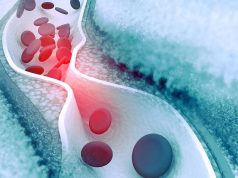Excess rate of muscle-related adverse event reports when patients are aware that statins being used
FRIDAY, May 5, 2017 (HealthDay News) — The rate of muscle-related adverse event (AE) reports is increased when patients and their doctors are aware that statins are being used, according to a study published online May 2 in The Lancet.
Ajay Gupta, M.B.B.S., M.D., from Imperial College London, and colleagues randomized patients aged 40 to 79 years with hypertension, at least three other cardiovascular risk factors, and fasting cholesterol concentrations of 6.5 mmol/L or lower to atorvastatin 10 mg daily or matching placebo (5,101 and 5,079 patients, respectively). All patients were offered atorvastatin 10 mg daily open label in a subsequent non-randomized, non-blind extension phase (9,899 patients).
The researchers found that during the blinded phase, the rate of muscle-related AEs (2.03 versus 2.00 percent) and erectile dysfunction (1.86 versus 2.14 percent) were reported at a similar rate by participants randomized to atorvastatin or placebo. The rate of sleep disturbance was significantly lower among participants randomized to atorvastatin (1.00 versus 1.46 percent). During the non-blinded phase, participants taking statins reported muscle-related AEs at a significantly higher rate (1.26 versus 1.00 percent per annum). No significant differences were seen between statin users and non-users in the rates of other AEs.
“These analyses illustrate the so-called nocebo effect, with an excess rate of muscle-related AE reports only when patients and their doctors were aware that statin therapy was being used and not when its use was blinded,” the authors write.
Several authors disclosed financial ties to pharmaceutical companies, including Pfizer, which partially funded the study with Servier Research Group and Leo Laboratories.
Copyright © 2017 HealthDay. All rights reserved.








